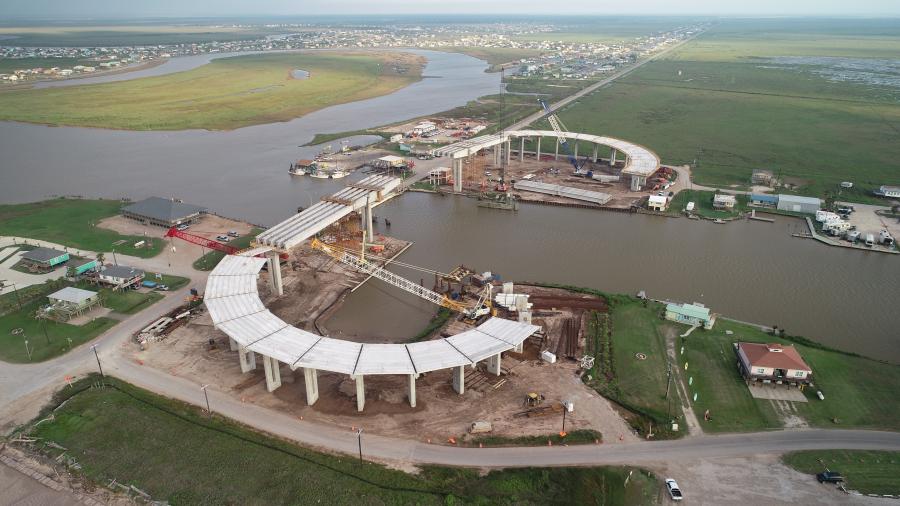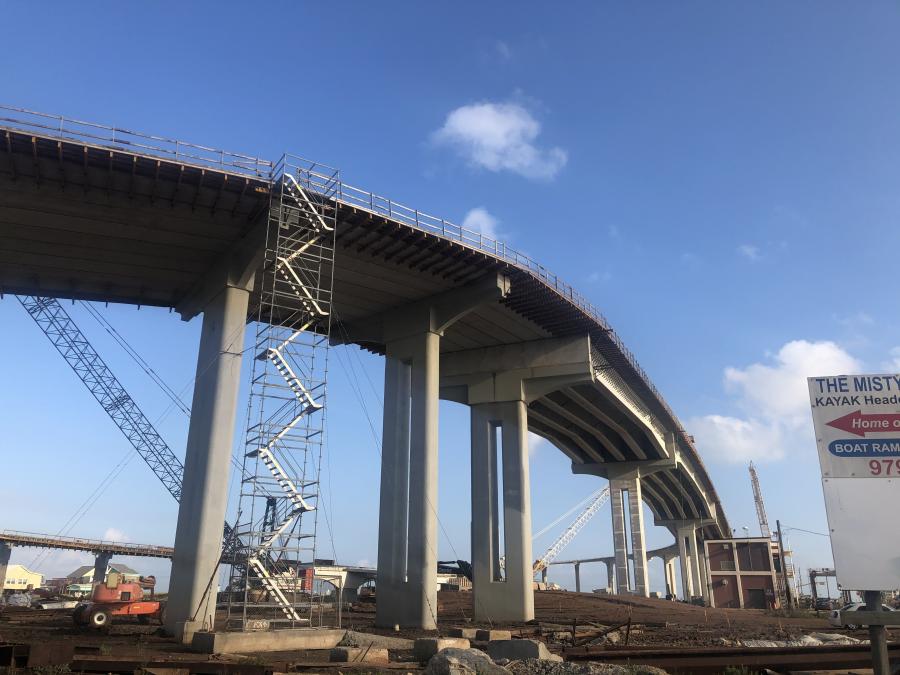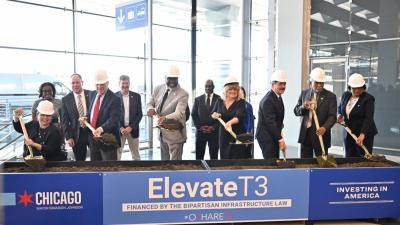Crews from Austin Bridge & Road utilized spliced girder technology, rebuilt a span with a unique bridge geometry and precast components at a challenging site in Sargent, Texas, to deliver the $41 million FM 457 swing bridge reconstruction project.
When Austin Bridge & Road Inc. was tapped to deliver the $41,200,000 replacement of the FM 457 Swing Bridge (Matagorda Bridge) in Sargent, Texas, its crews knew it would be in for a challenging endeavor.
Dealing with numerous constraints, needing to employ spliced girder technology and rebuilding a bridge with a unique geometry within a limited footprint — located on the Gulf Intracoastal Waterway (GIWW) — all made this project a monumental feat to complete.
The project began in October 2018 and was delivered on-time and on-budget last spring with a 300-ft. main span and flanking tight radius corkscrew approach spans. Constraints such as narrow barrier island just a few hundreds of yards wide and a national wildlife refuge dictated the unique geometric approach. The work included the construction of new approaches to the bridge and water elements, which were completed after the bridge was constructed.
"It was struck by barges about once a month, making it the second-ranked impediment to navigation on the Texas portion of the GIWW," said Michael Hyzak of TxDOT's bridge division.
The new span provides 75 ft. of vertical clearance above the water and features the longest spliced precast girder span in the state at 300 ft. Clearance requirements were to satisfy GIWW requirements and keep the main piers out of the waterway. It is a 690-ft-long, cast-in-place, prestressed concrete spliced-girder unit and 1,675 ft. of shallow precast, prestressed concrete slab beam approach spans in 43-ft.-long spans on a 150-ft.-radius centerline curve.
Project Challenges
The project faced many hurdles that had to be overcome.
"We faced hurdles ranging from active vessel traffic to erratic weather to limited space for heavy lifts," said Jonathan Knoll, Austin Bridge & Road's project manager. "Daily troubleshooting helped push the 27-month project forward. A detailed logistics plan, crane mats and truck mats helped us overcome the challenges of the site's soft soils. The tight space hindered the movement of large cranes, making heavy lifts more complex."
The biggest challenge was lifting heavy concrete elements within a small work zone.
"Critical crane pick plans were completed for setting precast caps and beams into their final position," said Knoll. "Pick plans also were developed to load and unload caps and beams from the barge due to large size of materials and the outdated swing bridge which could not safely be travelled on by truck and trailer. The main span precast caps weighed 272,000 pounds, corkscrew caps were 158,000 pounds, pier girder beams were 310,000 pounds and center precast spliced girders were 330,000 pounds. The limited work space and weight of the center precast spliced girder beams led to the use of Freyssinet to lift the beams with strand jacks instead of cranes.
"Furthermore, portions of the project were located in wetland areas that required increased communication with TxDOT environmental managers to complete the project following protocols and protecting the sensitive work area," he added. "The soil conditions were consistently wet and loose and extra attention was necessary when excavating for footer construction. This factor led to crane mats which were often double or triple stacked during heavy lifts to ensure cranes stayed level."
With the site along the coast of the Gulf of Mexico, reliable weather reports were essential to scheduling operations, safety programs for the crews and public, and in case of storms, preparing for evacuations.
A temporary trestle bridge was constructed in the Intracoastal Waterway to construct the four bridge bents within the waterway.
"This trestle bridge allowed for a 300 ton crawler crane to walk close to these four bents for pipe pile installation, setting precast caps and building the two marine dolphin structures," said Knoll.
Despite the many challenges, no re-work was required.
"We focused on planning, innovative designs and quality control," said Knoll. "Extra care had to be given when forming and pouring beam diaphragms and splices to ensure all post tensioning ducts were connected properly and free of water or debris. This allowed the post tensioning operations to occur smoothly and without any quality issues. Each corkscrew deck pour required extra labor and supervision to ensure the seven percent running slope and two percent cross slope was on grade. The focus on quality during deck placement resulted in a smooth ride for the traveling public."
ABR supplied its own 200-ton crawlers cranes — LinkBelt 248s and Bigge crane supplied a Manitowoc 2250, a 300-ton crawler crane and two Manitowoc 16000s, which are 440-ton crawler cranes.
Peak days had 45 construction workers on-site, with the subcontractors being DSI (DYWIDAG-Systems International) for post-tensioning; Freyssinet Inc., J&S Contractors, Lone Star Paving, Matagorda Construction, Webber LLC and Bexar Concrete Works produced many of the precast elements; Harris Rebar Nufab provided the reinforcing steel; EFCO Forming/Shoring and PERI Concrete Column Forms the formwork, CMC Commercial Metals the expansion joints; and D.S. Brown the bearings. Matagorda Concrete supplied the concrete.
Safety was a constant priority, which led to a 1.0 OSHA record incident rate and a 0.0 list time accident rate.
‘We experienced unique safety hazards not commonly encountered on typical heavy civil/highway project," said Knoll. "The safety program and site-specific plans mitigated these hazards and provided great safety results. Typical bridge work, even in flyovers, are 25 feet to 50 feet from ground level, whereas the main spans of this bridge were 90 feet in height. This alone is not a huge issue, but being on the coast, a constant wind of 10 to 15 mph provided concerns. A portion of this work was at heights not on a level surface, but often under or between beams and in hard to access areas, specifically on the CIP diaphragm work.

"The team recognized that the combination of these conditions warranted a specific safety plan, training, protocols and JHA discussions daily," he added. "We decided to stop work at heights when the winds exceeded 25 mph or provided field personnel the authority to stop work when they felt uncomfortable. Scaffolding with handrail was constructed at the tops and bottoms of each girder diaphragm providing a staging area and stable work area that reduced the hazards when compared to a horizontal lifeline and/or working fully out of a man-lift. Workers with previous height experience were selected and retrained on these specific hazards and type of work. This resulted in zero fall, drop or height incidents."
During the construction, barges travelled through the project site nearly every 30 minutes
"OSHA requirements for working near or over water were followed and barge traffic was treated similar to highway traffic with protocols in place to ensure no equipment or personal could be struck or potentially damage to any vessels," said Knoll. "The largest engineering control put into place was electing to construct the bridge from land as much as possible by utilizing larger cranes and a drop strand system to erect the center girder span. This reduced the number of cranes on barges, reduce cranes on barges to avoid the safety concerns involved with these operations and to reduce congestion within the Intracoastal Waterway. The plan worked effectively and resulted in zero water incidents to construction crews or to vessel traffic." CEG
Today's top stories


























